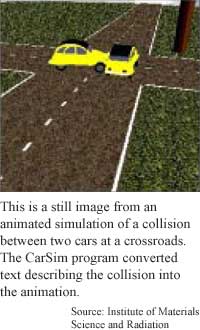
Software
spins tales into animations
By
Chhavi Sachdev,
Technology Research NewsWhen people describe or dispute accidents, verbal testimony is often paired with a series of sketches or animations depicting the events. Illustrations add more depth and detail to reports, but manually producing them can be time-consuming work.
A group of researchers in France has developed software that could eventually give forensic experts and insurance investigators a dynamic picture of what happened by automatically turning the words into a computerized simulation.
“We have designed and implemented a system that takes written car accident reports as an input and produces three-dimensional worlds where the entities involved in the accidents are recreated and animated,” said Pierre Nugues, now a computer science professor at the Lund Institute of Technology in Sweden.
The accident-generating system, dubbed CarSim by its creators, translates a written accident report into a symbolic template or formalism, and uses that to generate a three-dimensional animation of the scene.
Beyond courtroom and insurance analyses, “CarSim could be used by media companies, advanced Web sites, or education institutes to recreate dynamic descriptions from texts,” Nugues said.
Another potential use is in training drivers. The U.S. National Transportation Safety Board maintains thorough summaries of accident reports that are difficult to visualize or understand, said Nugues. “Imagine a system that would read a text and generate…a virtual world where you could be the driver. So a possible application would be to use CarSim to train drivers [to avoid] accidents in dangerous situations,” he said.
However, there is not much precedent to build on in the fields of visualization and language, according to Nugues. Systems that try to automatically convert words into images generally produce two-dimensional sketches.
CarSim's visualizer creates and animates a three-dimensional world from words using images and motions from a database, said Nugues. Textual accident reports that are converted to motion contain several entities designated by nouns and pronouns. The report, for example, may refer to two cars, one tree, and one or more roads. The program delineates entities as either moving or static.
The program maps out the initial directions of the vehicles involved in an accident, and the events that led to it using parameters such as overtaking and turning. The program processes these parameters to generate a virtual scene.
It is hard to convert text into motion automatically, Nugues said. This is evident from the results of the CarSim experiments. When the system was first given texts from real accident reports, it generated a satisfactory animated scene only 17 percent of the time.
The researchers increased the accuracy to 35 percent after improving the initial direction detection in the simulator and adding a coreference resolution mechanism, Nugues said. "Coreference resolution is a step that determines sets of nouns or pronouns that refer to the same entity," said Nugues. This eliminates the possibility of an entity being counted again.
The cause of the low accuracy lies both in transforming the symbolic formalism into visuals and in automatically converting the language used in the accident report into the formalism, according to Nugues. When the researchers manually wrote a formalism from the natural text, accident simulation accuracy rose to almost 60 percent, he said.
The researchers hope to improve the system to at least 50 percent accuracy in recreating accidents, said Nugues. The current system works with French text and has a limited number of movements in its database.
CarSim is an interesting combination of natural language research and traffic simulation, said Jan Allbeck, Technical Manager of the Center for Human Modeling and Simulation at the University of Pennsylvania. But the system lacks some useful attributes, she said.
“Their representation of accidents is very limited. They can represent only cars -- no motorcycles [or] trucks. They cannot represent speed or degrees of turns or road conditions,” Allbeck said. Therefore, the simulation is likewise limited, she said.
The researchers plan to study more motion verbs to reproduce them more accurately, said Nugues. They are also planning to better label real motions and name them to reflect subtle variations, he said.
One way to do this would be by using motion-capture devices to observe people and name what they are doing, he said. “We already had a small experiment with dancers that recorded arabesques. We would like to design a system that would analyze the captured data and [recognize] that they are doing arabesques,” Nugues said.
Nugues's research colleagues were Sylvain Dupuy and Vincent Legendre at the Institute of Science of Matter and Radiation (ISMRA) in France and Arjan Egges, from the University of Twente in Holland. The research was funded by the Institute. It could be in practical use within 5 years, said Nugues.
Timeline: > 5 years
Funding: Institutional
TRN Categories: Natural Language Processing; Graphics
Story Type: News
Related Elements: Technical Paper: "Generating a 3D Simulation of a Car Accident from a Written Description in Natural Language: The CarSim System.” Presented at the Association for Computational Linguistics Conference (ACL 2001) in Toulouse, France on July 7, 2001
Advertisements:
September 5, 2001
Page One
Pen and paper networked
Quantum current closer to computing
Correction choices key for speech software
Software spins tales into animations
Watched quantum pot boils slower

News:
Research News Roundup
Research Watch blog
Features:
View from the High Ground Q&A
How It Works
RSS Feeds:
News
Ad links:
Buy an ad link
| Advertisements:
|
 |
Ad links: Clear History
Buy an ad link
|
TRN
Newswire and Headline Feeds for Web sites
|
© Copyright Technology Research News, LLC 2000-2006. All rights reserved.